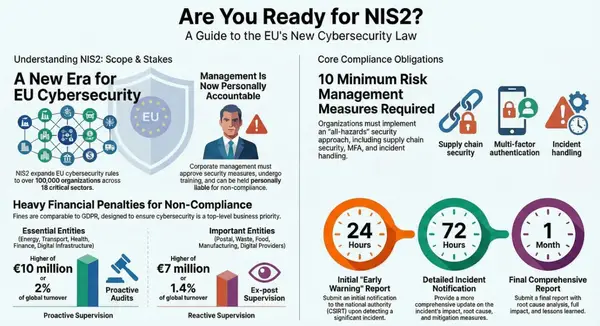Beyond Reaction: Integrating Incident Response into Your Cybersecurity Risk Management Strategy with NIST SP 800-61r3

In today's dynamic threat landscape, cybersecurity incidents are an unfortunate reality for organizations of all sizes and sectors. The ability to effectively handle these events is no longer a siloed IT function but a critical component of overall cybersecurity risk management. Integrating incident response recommendations and considerations throughout an organization's risk management activities can significantly improve preparedness, reduce the number and impact of incidents, and enhance the efficiency of detection, response, and recovery efforts.
Recognizing this evolution, the National Institute of Standards and Technology (NIST) has published NIST Special Publication (SP) 800-61 Revision 3, titled "Incident Response Recommendations and Considerations for Cybersecurity Risk Management: A CSF 2.0 Community Profile". This publication is specifically designed to help organizations incorporate incident response throughout their cybersecurity risk management activities as described by the NIST Cybersecurity Framework (CSF) 2.0. It offers a common language and structure for these efforts by using the CSF 2.0 Functions, Categories, and Subcategories.

The Pillars of Integration: Incident Response and the CSF 2.0 Functions
NIST SP 800-61r3 positions incident response as an integral part of cybersecurity risk management. The CSF 2.0 framework provides a useful model for understanding this integration through its six core Functions:
- Govern (GV)
- Identify (ID)
- Protect (PR)
- Detect (DE)
- Respond (RS)
- Recover (RC)
These functions play vital roles throughout the incident response lifecycle. The first three functions – Govern, Identify, and Protect – are crucial for preparation activities. They help organizations prevent certain incidents, prepare to handle those that do occur, and reduce their potential impact. These are considered broader cybersecurity risk management activities that support incident response.
The latter three functions – Detect, Respond, and Recover – focus on the actions taken during and immediately after an incident. They guide organizations in discovering, managing, prioritizing, containing, eradicating, and recovering from cybersecurity incidents. Incident reporting, notification, and other incident-related communications are also encompassed within these functions.
Building the Foundation: Preparation through Govern, Identify, and Protect
Integrating incident response effectively begins long before an incident occurs. The CSF 2.0 functions of Govern, Identify, and Protect provide the necessary foundation:
- Govern (GV): This function ensures that legal, regulatory, and contractual requirements related to incident notifications and data breach reporting are understood and managed. Policies are essential for governing cybersecurity incident response, typically including a statement of management commitment, purpose, scope, and definitions of events and incidents. Policies should also define roles, responsibilities, and authorities, such as who can disconnect assets. Leadership oversight and funding allocation are part of governance. Responsibilities with third parties (like service providers) should be clearly defined, potentially through contracts and NDAs.
- Identify (ID): Risk assessment practices are critical for understanding the cybersecurity risk to assets and individuals. This understanding is fundamental to reducing the number and impact of incidents. Identifying and recording threats, potential impacts, and the likelihood of vulnerabilities being exploited informs the prioritization of risk responses.
- Protect (PR): While comprehensive protective measures are outside the direct scope of NIST SP 800-61r3, the publication notes that practices like managing access controls commensurate with assessed risk can benefit incident response activities.
Activating the Response: Detection, Response, and Recovery
Once an adverse cybersecurity event is suspected, the focus shifts to the Detect, Respond, and Recover functions:
- Detect (DE): This function involves all monitoring and analysis activities aimed at finding and characterizing potentially adverse events and, subsequently, finding cybersecurity incidents. Continuous monitoring is performed to find anomalies and indicators of compromise. Adverse event analysis is then used to study collected data, find possible attacks, and declare an incident to initiate response activities. Due to the high volume of data, organizations should rely on technical solutions to filter events for human review. Leveraging cyber threat intelligence (CTI) can be invaluable for early detection, reducing impact and recovery time. The goal is to find incidents earlier in the attack life cycle.
- Respond (RS): This function covers managing the incident, including prioritization, containment, eradication, and recovery initiation. Prioritizing incidents can involve factors like asset criticality, functional impact, and data impact. Tracking the status of each incident is crucial. Mitigation activities prevent the incident from expanding. Containment can be manual or automated. While redirecting attackers to a sandbox for monitoring is a consideration, the incident response team must consult with the legal department due to the potential risks involved. Eradication involves eliminating persistence mechanisms, deleting malware, disabling breached accounts, and mitigating exploited vulnerabilities. Identifying all affected hosts is necessary for remediation. Automated eradication can be considered, and third parties like ISPs or CSPs might be authorized to act. Incident analysis involves recording actions and preserving evidence integrity. Effective communication is vital during response, including coordination among internal/external parties, formal notification of affected parties (customers, regulators), and public communication. Following organizational policies on media interaction is necessary. Sharing cybersecurity threat information voluntarily is encouraged.
- Recover (RC): This function focuses on restoring affected capabilities and services. For data breach incidents, organizations should follow established breach notification procedures. It is important to explain the steps being taken for recovery and to prevent recurrence.
Essential Components for Effective Incident Response Integration
Beyond aligning with the CSF Functions, successful incident response integration relies on several key components:
- Incident Response Plan (IRP): A written plan, approved by senior leadership, is the roadmap for implementing incident response capabilities. Policies, processes, and procedures should be based on this plan. Documented procedures explaining technical and operational steps should be tested periodically. Procedures for common incidents and critical emergency processes are particularly important to document.
- Incident Response Team (CSIRT): Establishing a dedicated team, whether in-house or outsourced (like through an ISAC), is highly recommended. This team should include IT and cybersecurity experts, and may involve legal, public affairs, and human resources personnel depending on the incident's nature. Clearly defined roles, responsibilities, and authorities are paramount.
- Technology and Expertise: Investing in appropriate technology, such as Security Information and Event Management (SIEM), Endpoint Detection and Response (EDR), and forensic tools, is crucial for detection, analysis, containment, and eradication. Leveraging the expertise of security professionals is equally important. Service providers can offer benefits like faster detection by correlating events, but organizations must also consider and address the risks associated with service provider access.
- Continuous Improvement: Incident response is an iterative process. Lessons learned from analyzing incidents and performing root cause analysis are vital for improving overall cybersecurity risk management and governance efforts. Post-incident activities, including documenting the incident and conducting "Lessons Learned" meetings, are essential for feeding insights back into policies, plans, and practices. This continuous feedback loop is necessary to adapt to the constantly evolving threat landscape.
- Communication and Coordination Protocols: Predefined protocols and mechanisms for communication, both internal and external, are essential for effective coordination during a response. Sharing security knowledge with other organizations is encouraged.
Conclusion
Integrating incident response into your organization's overall cybersecurity risk management strategy is not just a best practice; it's a strategic necessity. By adopting the guidance provided in publications like NIST SP 800-61r3 and leveraging the structured approach of the CSF 2.0 framework, organizations can move beyond merely reacting to threats.
Embracing the principles outlined in NIST SP 800-61r3 – from foundational preparation activities within the Govern, Identify, and Protect functions, through the core incident handling actions of Detect, Respond, and Recover, to the crucial practice of continuous improvement – organizations can build a more resilient and effective cybersecurity posture. This integrated approach ensures that incident response capabilities are not isolated processes but are deeply embedded, supported, and continuously refined within the broader framework of managing cybersecurity risks. This proactive approach ultimately helps organizations prepare for incidents, reduce their number and impact, and enhance the overall efficiency and effectiveness of their security operations.






